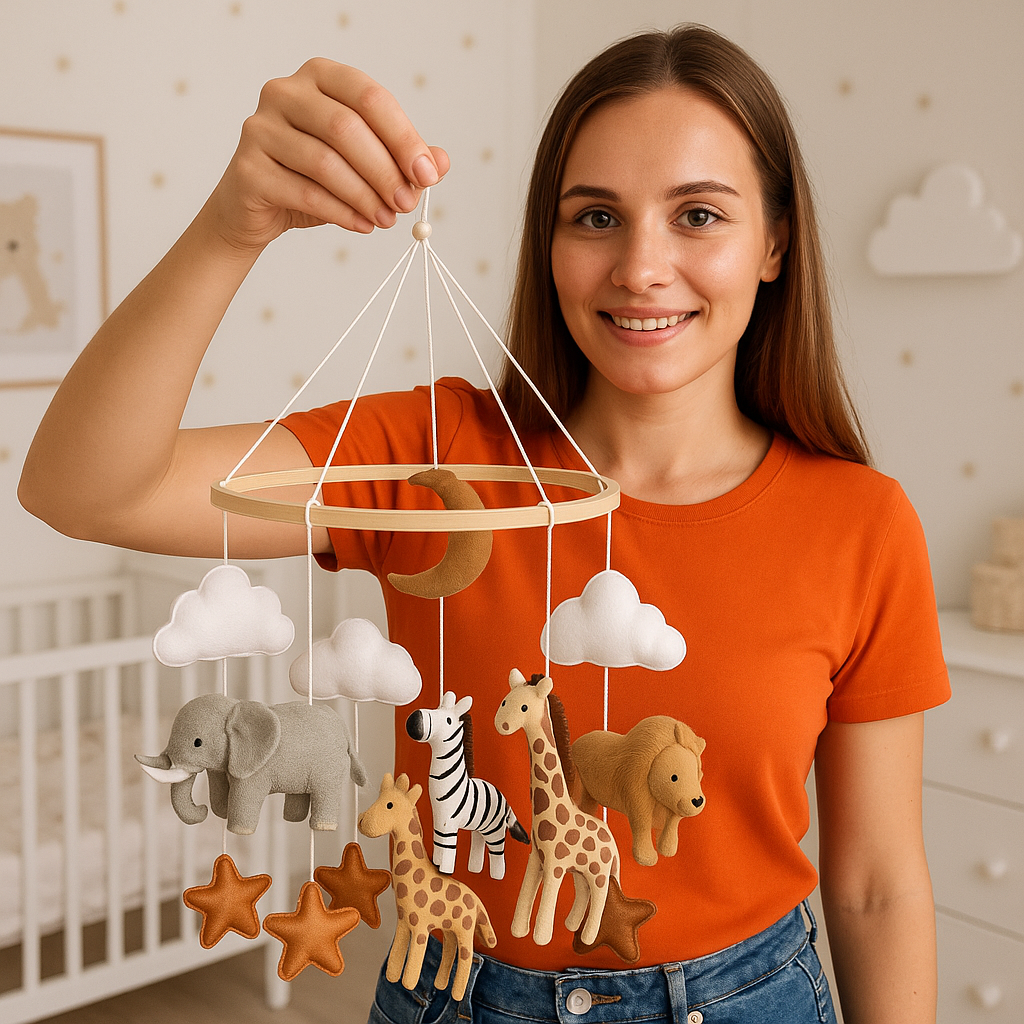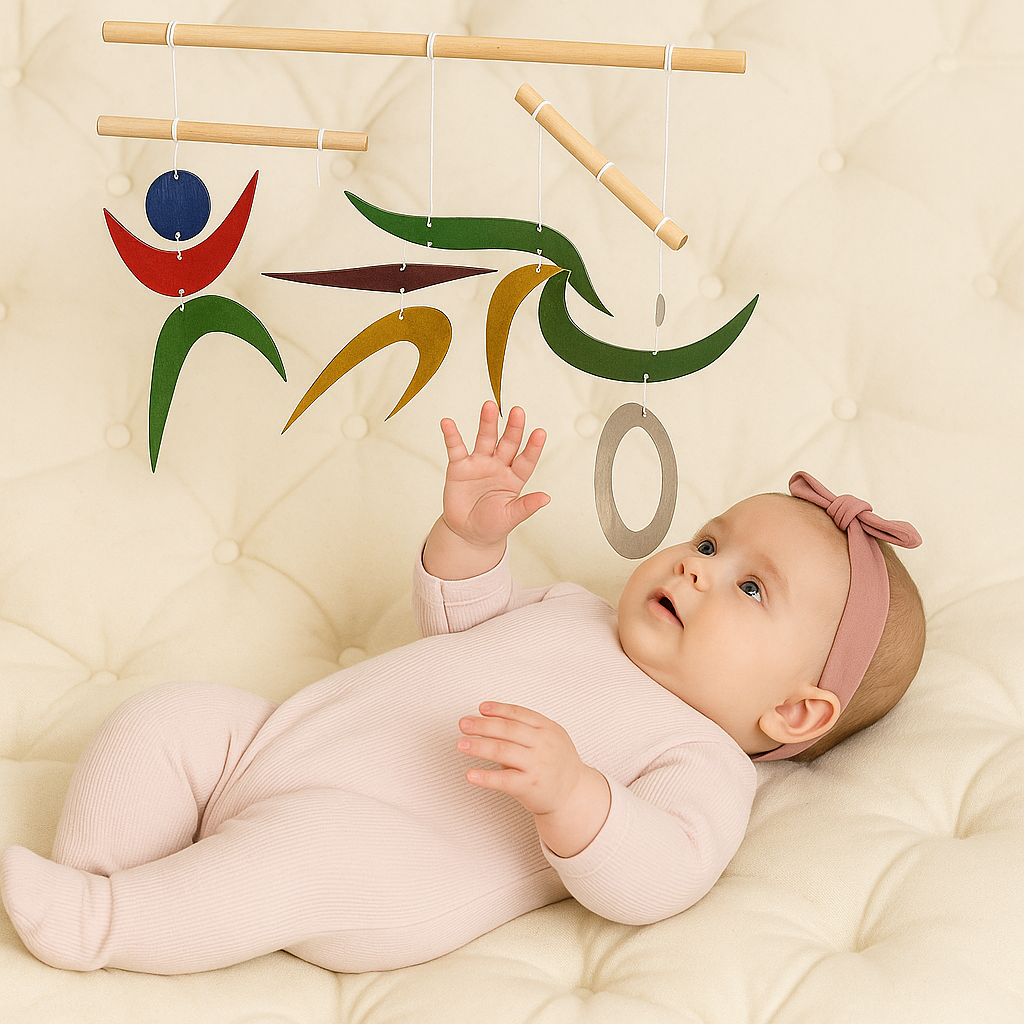How to Hang a Crib Mobile Safely: Placement, Height, and Materials 🌟
Creating a safe and stimulating nursery environment for your little one involves many important decisions, and learning how to hang a crib mobile safely is one of the most crucial skills for new parents. A properly installed mobile provides wonderful visual stimulation for babies while ensuring their complete safety throughout those precious early months. This comprehensive mobile installation guide will walk you through every step of the process, from choosing the right tools to achieving the perfect placement for optimal development and security.
Understanding Crib Mobile Safety Fundamentals 🛡️
Before diving into hanging mobile instructions, it's essential to understand the critical safety considerations that govern proper mobile installation. Mobile strings should never be longer than 7 inches to prevent tangling hazards, and the entire mobile system must remain completely out of your baby's reach throughout its use.
The foundation of crib mobile safety lies in understanding that these decorative nursery items serve a dual purpose: providing developmental benefits while maintaining the highest safety standards. Every aspect of installation, from height placement to material selection, must prioritize your baby's wellbeing above all aesthetic considerations.
Key Safety Principles:
- Always maintain proper distance from baby's reach
- Use only appropriate materials and hardware
- Regular inspection and maintenance protocols
- Understanding when removal becomes necessary
- Proper positioning to avoid entanglement risks
Essential Tools to Hang Mobile Successfully 🔧
Gathering the right tools to hang mobile installations ensures a secure, professional result that will withstand daily use throughout your baby's developmental stages. The specific tools required depend on your chosen mounting method, but having a comprehensive toolkit ready simplifies the entire process.
Basic Installation Tools:
- Stud finder for ceilings: Essential for locating secure mounting points in ceiling joists
- Drill with appropriate bits: For creating precise holes in various materials
- Screwdriver set: Both Phillips and flathead varieties for different screw types
- Level: Ensures perfect mobile positioning for optimal visual appeal
- Measuring tape: Critical for achieving proper mobile height above crib
- Pencil: For marking mounting locations accurately
- Safety glasses: Protection during drilling and installation procedures
Hardware Options:
- Screw hook installation: Traditional method for permanent ceiling mounting
- Toggle bolts: For hollow ceiling installations without stud access
- Furniture anchors: Alternative mounting solutions for specific situations
- Adhesive hooks: Temporary options for rental properties or lightweight mobiles
Determining the Perfect Mobile Height Above Crib 📏
The recommended mobile height above crib is approximately 12 to 16 inches above the mattress surface, though this measurement requires careful consideration of your individual baby's developmental stage and visual capabilities.
For newborns, positioning the mobile about 10 inches above their play area optimizes visual engagement, as babies can typically see clearly within an 8-10 inch range from their face. This strategic placement ensures maximum developmental benefits while maintaining essential safety margins.
Height Considerations by Age:
- Newborn to 2 months: 12-14 inches above mattress for optimal visual focus
- 2 to 4 months: 14-16 inches as reaching abilities begin developing
- 4+ months: Consider removal as sitting and reaching capabilities emerge
Adjustment Factors:
- Ceiling heights in your nursery
- Crib mattress position settings
- Mobile size and hanging elements
- Baby's individual developmental progress
- Visual tracking improvements over time
Comprehensive Mobile Installation Guide: Step-by-Step Process 📋
Following proper hanging mobile instructions ensures both safety and optimal developmental benefits. This detailed installation process covers every aspect of secure mobile mounting, from initial planning through final safety checks.
Pre-Installation Planning Phase 🎯
Baby Nursery Layout Assessment: Begin by carefully evaluating your complete baby nursery layout to identify the optimal mobile location. Consider furniture placement, lighting conditions, and traffic patterns that might affect both installation and daily use. Complete your nursery decoration process before final mobile installation to avoid unnecessary holes or repositioning.
Safety Zone Mapping: Create an imaginary safety zone around the crib, ensuring the mobile installation won't interfere with other nursery activities. Consider changing table proximity, nursing chair placement, and doorway clearances that might affect the hanging location.
Installation Method Selection 🏗️
Ceiling-Mounted Installation: Ceiling mounting provides the most stable and secure option for heavy or elaborate mobiles. This method requires careful stud location and appropriate hardware selection based on your ceiling construction type.
Mounting Options for Mobiles:
- Direct stud mounting: Most secure option for substantial mobiles
- Toggle bolt installation: Suitable for hollow ceiling areas without stud access
- Ceiling anchor systems: Heavy-duty options for plaster or concrete ceilings
- Beam-mounted alternatives: For exposed ceiling beam configurations
Crib Rail Attachment: Some mobile systems include crib arm attachments that clamp directly to crib rails. While convenient, ensure these attachments meet current safety standards and don't create additional hazards.
Detailed Installation Steps 🔨
Step 1: Location Marking and Measurement Using your measuring tape, carefully mark the exact installation point that achieves proper mobile height above crib while ensuring optimal visual angles. Use a pencil for light marking that can be easily erased if adjustments become necessary.
Step 2: Stud Location and Verification Use your stud finder for ceilings to locate the nearest structural support. Mark stud locations clearly, as mounting directly into structural elements provides the strongest installation foundation.
Step 3: Pilot Hole Creation Drill appropriate pilot holes based on your chosen hardware. For screw hook installation, use a drill bit slightly smaller than the hook's threaded portion to ensure tight engagement without material splitting.
Step 4: Hardware Installation and Testing Install your chosen mounting hardware, whether screw hooks, toggle bolts, or specialized mobile mounting systems. Test each installation point with gentle pressure before hanging the actual mobile.
Step 5: Mobile Assembly and Attachment Complete mobile assembly according to manufacturer specifications, paying particular attention to string lengths and component security. For DIY installations, ensure all string connections are secure and measure exactly to maintain proper proportions.
Material Safety and Selection Guidelines 🧵
Choosing appropriate materials for your mobile installation directly impacts both safety and longevity. Every component, from hanging materials to decorative elements, must meet strict safety standards for nursery environments.
Safe Hanging Materials:
- Fishing line for mobiles: Nearly invisible and incredibly strong, ideal for minimalist aesthetics
- Cotton cord: Natural material that's soft yet durable for traditional mobile designs
- Metal chains: Professional-grade option for heavy mobiles requiring maximum security
- Ribbon alternatives: Avoid traditional ribbons due to string hazards and choking concerns
Component Safety Evaluation: Examine every mobile component for potential safety issues. Remove or replace any elements with sharp edges, small parts that could become choking hazards, or materials that might shed fibers or particles into the crib environment.
Material Durability Testing: All hanging materials should withstand regular movement and potential environmental factors like humidity changes in the nursery. Test material strength before installation and plan regular inspection schedules.
Addressing String Hazards and Choking Prevention 🚨
String hazards represent one of the most serious safety concerns, with strings longer than 7 inches posing significant entanglement risks. Understanding and mitigating these risks requires careful attention to every hanging element in your mobile design.
String Length Management: Measure every string, cord, or hanging element to ensure compliance with safety guidelines. When in doubt, err on the side of caution by shortening questionable elements or choosing alternative attachment methods.
Choking Hazards Prevention: Avoid hanging anything near your baby's crib with strings or ribbons, as these represent serious choking hazards even when positioned seemingly out of reach. Regular inspection ensures no components become loose or damaged over time.
Component Security Protocols: Implement regular checking schedules for all mobile components, examining attachment points, material wear, and overall structural integrity. Replace worn components immediately rather than risking safety compromises.
Safe Nursery Practices and Environmental Considerations 🏡
Creating secure baby environments extends beyond mobile installation to encompass comprehensive nursery safety protocols. Understanding how your mobile fits into the broader safety ecosystem helps maintain optimal protection throughout your baby's development.
Nursery Design Integration: Position your mobile to complement other safety measures rather than creating conflicts. Ensure adequate clearance from light fixtures, ceiling fans, or other hanging elements that might create hazards.
Environmental Safety Factors: Consider temperature fluctuations, air circulation patterns, and natural lighting that might affect mobile materials or positioning over time. Plan for seasonal adjustments or environmental changes that could impact safety.
Advanced Installation Techniques and Alternatives 🎨
For parents seeking creative solutions or facing installation challenges, several advanced techniques provide safe alternatives to traditional mounting methods.
DIY Mobile Hanging Solutions: Creative parents can develop custom mounting solutions using approved hardware combinations. Always prioritize safety over aesthetics, and consult with hardware professionals for complex installations.
Temporary Mobile Installation: For rental properties or temporary situations, consider adhesive strips or tension-based systems that avoid permanent ceiling modifications. Ensure these temporary solutions maintain the same safety standards as permanent installations.
Alternatives to Drilling: Explore innovative mounting solutions like ceiling-mounted tracks, adjustable rod systems, or furniture-mounted options that provide flexibility without compromising safety standards.
Montessori Mobiles and Developmental Considerations 🎭
Understanding different mobile types helps parents choose installation methods that optimize developmental benefits. Montessori mobiles, in particular, require specific positioning for maximum educational impact.
Montessori Mobile Positioning: These specialized developmental tools require precise positioning to support visual tracking development and cognitive growth. Follow Montessori principles for height, angle, and environmental integration.
Developmental Progression Planning: Plan for mobile changes as your baby develops, considering how installation methods might accommodate different mobile types throughout various developmental stages.
Maintenance, Adjustment, and Safety Monitoring 🔍
Successful mobile installation extends beyond initial setup to include ongoing maintenance and safety monitoring protocols that ensure continued protection throughout use.
Regular Inspection Schedules: Establish weekly inspection routines that check all mounting points, material conditions, and overall stability. Document any changes or concerns for trending analysis.
Mobile Adjustment Tips: Learn to make minor height or position adjustments safely without compromising installation integrity. Keep adjustment tools easily accessible for quick modifications as needed.
Best Mobile Hooks and Hardware Longevity: Invest in quality hardware that will withstand extended use and environmental factors. Plan replacement schedules for wear-prone components before safety compromises develop.
Conclusion: Creating Lasting Safety and Beauty ✨
Learning how to hang a crib mobile safely represents a fundamental parenting skill that combines aesthetic vision with uncompromising safety standards. By following these comprehensive guidelines, choosing appropriate materials, and maintaining proper installation protocols, you're creating a beautiful, developmentally beneficial, and completely safe environment for your precious little one.
Remember that mobile installation is just one component of comprehensive nursery safety. Continue educating yourself about evolving safety standards, developmental milestones that affect mobile use, and proper maintenance procedures that ensure your installation remains safe and beneficial throughout its intended use period.
The time and attention you invest in proper mobile installation will reward your family with countless hours of safe, engaging visual stimulation that supports your baby's healthy development while providing the peace of mind that comes from knowing you've prioritized safety above all other considerations. 🌈




Leave a comment
This site is protected by hCaptcha and the hCaptcha Privacy Policy and Terms of Service apply.